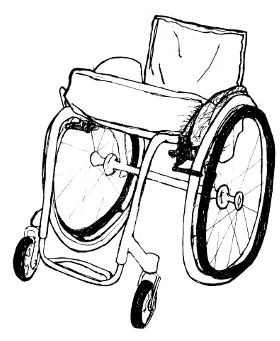BREYDON’s wheelchair trials: Küschall The KSL [Mark 1?]
breydon.id.au/locomote/trials/kueschall/ksl
Wednesday 21 April 2021.
Updated 03 August 2021.
Welded, monotube chair.
An ultralight monotube wheelchair bearing a thick cushion and huge rubbery pushrims.

1. Assessment
Getting warmer! I was wonderfully surprised how short (front‐to‐back) this mystery chair was (until finding out the make and model).
At 380 mm, the seat width starts to become steerable for me (though 360 mm or less would be better). This demonstrator still got stuck at narrower doors. Lose the camber, go for a 340 mm or 360 mm wide seat, choose smallest skate wheels — and it would slide through effortlessly both backwards and forwards, hold me more comfortably and be much less hassle in tricky spaces at difficult times! Would be safer for dance and skating, that way, too.
This particular chair propped me a couple of centimetres too high up off the ground, at which height the centre of gravity (~ 110 mm?) was slightly too far back for going up slopes safely. Easy fix: would need only spec it a bit lower, and maybe use an anti‐tipper on very wonky occasions. (Keeping in mind that carrying stuff — water bottle, daypack… — relatively low and forward on the frame will affect centre of gravity, too.)
Seat‐back was tension‐adjustable at half a dozen or so levels. Salesperson meddled with the tensioners without my consent while I was stuck sitting in the compromised chair; he very quickly made it impossible for me to hold myself up or hold myself still or to move anywhere but into a fall. Yikes. (“Yikes” what a jerk and “yikes” how vulnerable this type of seat‐back makes one to mistakes.)
Two big concerns: fragile carbon‐fibre side‐guards… Could we weld on some sturdy ones instead? Or order a frame with bolt‐holes but no guards (carbon‐fibre being a tricky material to recycle, so v wasteful if surplus to needs), then pop on some wooden plates; or even just fashion something out of waxed canvas?
And is the chair as a whole robust enough to go skating regularly?
Note that the second generation KSL (The KSL 2.0) and the first may differ in important respects! In particular, the front of the 2.0 looks as though it might be easier to orient hands around during difficult transfers. It could be illuminating to compare them side‐by‐side.
1.1. Chair tried
| Seat width | 380 mm (15″) |
| Seat length | ~ 40 cm (~ 16″) |
| Backrest height | ? |
| Footrest height | ? |
| Hanger angle | 90° |
| Chair length | ~ 73 cm |
| Chair width | ~ 60 cm |
| Weight in use | ~ 6·5 kg |
| Frame material | ? |
| Footplate | Fixed |
| Wheel camber | −3° |
| Drive wheels (d.w.) | Two, towards rear |
| d.w. rims | ? |
| d.w. spokes | ? |
| d.w. hubs | ??‐hole |
| d.w. axles | quick‐release |
| d.w. tyres | ~ 25‐540 (24×1″), pneumatic |
| Push rims | thick and rubber‐coated |
| Castors | Two, 5×?″, towards front |
| ??? rim/hub/?‐spoke | |
| ??? tyres | |
| Model number | ? |
| Manufactured | ? |
2. Further reading
- Küschall, ‘The KSL’. https://kuschall.com/international-en/products/the-ksl/, accessed March 2021.